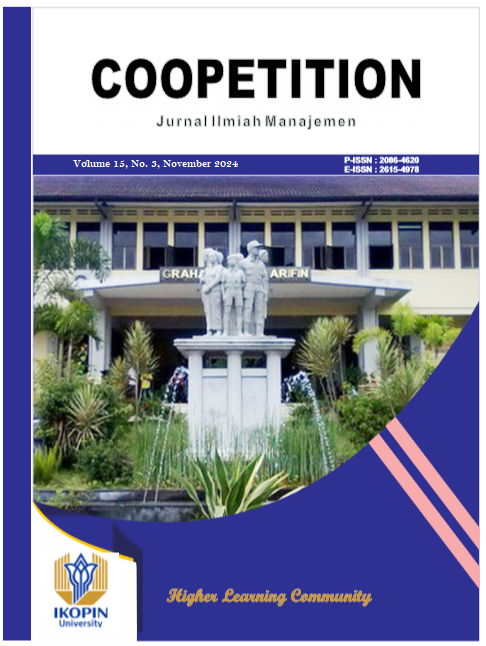Analisis Sumber Daya Perusahaan Dan Lingkungan Eksternal
Studi Kasus pada Industri Kreatif Digital Pasca Pandemik Covid 19
DOI:
https://doi.org/10.32670/coopetition.v15i3.4502Keywords:
digital creative industries, company resources, external environmentAbstract
This research highlights company resource variables and the external environment in the digital creative industry in West Java, which is registered with Aspiluki. There were 25 respondents in this study, consisting of owners and managers. This research uses quantitative and descriptive research methodologies. Company resources are everything that the company owns and can control. Meanwhile, the external environment is the environment outside the organization that can influence a company. The results show that the biggest indicator of the company resource variable is "the accuracy of using computer-based systems to analyze customer and market information." Meanwhile, the biggest indicator of external environmental variables is "the power of suppliers in determining costs to the company." The lowest indicator for the company resource variable is "developing and maintaining computer-based communication relationships with customers." Therefore, researchers suggest that companies should improve service quality by offering customer service 24 hours a day instead of normal office hours, which usually only involve 5 working days a week. Meanwhile, the lowest indicator for external environmental variables is "changes in government policies that affect digital creative businesses." Therefore, researchers suggest that the government provide policies that can provide more contributions to companies in the digital creative industries.
Downloads
References
Jurnal:
Carpenter, M.A. & Sanders, W.G. (2007) Strategic Management: A Dynamic Perspective. Pearson Prentice Hall, Upper Saddle River, NJ.
Foris, P. J., Mustamu, R. H. (2015). Analisis Strategi pada Perusahaan Plastik dengan Porter Five Forces. AGORA Vol 3 No 1 (2015)
Garrison, G., Wakefield, R. L., & Kim, S. (2015). The Effects of IT Capabilities and Delivery Model on Cloud Computing Success and Firm Performance for Cloud Supported Processes and Operations. http://dx.doi.org/10.1016/j.ijinfomgt.2015.03.001
Hitt, M. A., Ireland, R. D., & Hoskisson, R. E. (2017). Strategic Management: Competitiveness and Globalization: Concepts. Australia: Cengage Learning
Hsieh, Kai-Yu & Tsai, Wenpin & Chen, Ming-Jer. (2015). If They Can Do It, Why Not Us? Competitors as Reference Points for Justifying Escalation of Commitment. Academy of Management Journal. 58. 38-58. 10.5465/amj.2011.0869.
Krause, R., Semadeni, M., & Cannella, A. A. (2013). CEO Duality: A Review and Research Agenda https://doi.org/10.1177/0149206313503013
Mithas, S., Ramasubbu, N., Krishnan, M. S. & Sambamurthy, V. (2011). Information Technology Infrastructure Capability and Firm Performance: An Empirical Analysis.
Muazu, U. A., & Abdulmalik, S. (2021). Information Technology Capabilities and Competitive Advantage: A Review.
Oskarsson, G. (2009). Information Technology Capabilities and Their Impact on The Transfer of External Information: Implications for Both Private and Public Sector Organizations
Pamungkas, D. P. (2016). Analisis Competitive Force dan Competitive Strategy Sistem Informasi Kuliner di Indonesia (Studi Kasus: Kulina.id). Jurnal Electronics, Informatics, and Vocational Education (ELINVO), Volume 1, Nomor 2, Mei 2016
Putranto A. (2015). Government Chief Information Officer: Analisis Peran dan Kompetensi di Pemerintahan Indonesia. Disertasi Doktor. Jogjakarta: Universitas Gadjah Mada
Sakas, D. P., Vlachos, D., Dimitrios, N. K. (2014). Modelling Strategic Management for The Developmental of Competitive Advantage, Based on Technology. Journal of Systems and Information Technology, 16(3), 187-209
Sidiq, A., Astutik, E. P. (2017). Analisis Kapabilitas Teknologi Informasi Terhadap Kinerja Bisnis UKM dengan Orientasi Pelanggan Sebagai Variabel Intervening (Studi pada UKM Sektor Manufaktur di Wilayah Solo Raya). Media Ekonomi dan Manajemen Vol 32 No 1 Januari 2017
Stevens, C., Xie, E., & Peng, M. (2016). Toward a legitimacy-based view of political risk: The case of Google and Yahoo in China. Strategic Management Journal. 37. 10.1002/smj.2369.
Sumali. (2016). The Effect of School Based Management to Teacher Professionalism of Senior High School in Central Lampung. DOI: http://dx.doi.org/10.24127/gdn.v6i2.558 Vol 6, No 2 (2016) Page: 195-199
Buku:
Arikunto, S. (2013). Prosedur Penelitian: Suatu Pendekatan Praktik. Jakarta: Rineka Cipta.
East Ventures. (2021). Digital Competitiveness Index 2021: Towards Indonesia’s Digital Golden Era.
Gamble, J. E., Peteraf, M. A, & Thompson, A. A. (2015). Essentials of strategic management: the quest for competitive advantage. New York: McGraw-Hill.
Index 2020 Update: The Human Capital in the Time of COVID-19.
International Telecommunication Union (ITU) – Telecommunication Development Sector (ITU-D). (2019) http://www.itu.int
Penrose, E. T. (1959). The theory of the growth of the firm. New York: Villey.
Porter, M. E. (1980). Competitive Strategy Techniques for Analyzing Industries and Competitors. The Free Press, New York, NY.
Porter, M. E. (1985). Competitive Advantage, The Free Press, New York, NY.
Sekaran, U. (2013). Research Methods for Business. Jakarta: Salemba Empat.
Sugiyono. (2012). Metode Penelitian Bisnis. Bandung: Alfabeta.
Websites:
Downloads
Published
How to Cite
Issue
Section
License
Copyright (c) 2024 Coopetition : Jurnal Ilmiah Manajemen

This work is licensed under a Creative Commons Attribution 4.0 International License.


















